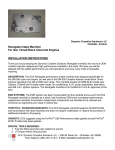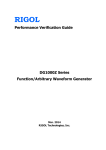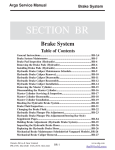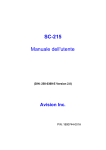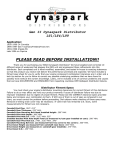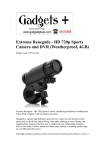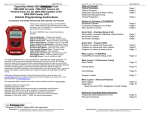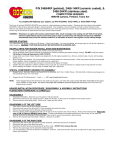Download Product Instructions
Transcript
Renegade Intake Manifold For Gen I Small Block Chevrolet Engines INSTALLATION INSTRUCTIONS Thank you for purchasing the Dynamic Crossfire Solutions Renegade manifold, the only true OEM crossfire injection replacement high performance manifold in the world. We hope you will be pleased with the added performance you will experience and have many miles of enjoyable motoring. DESCRIPTION: The DCS Renegade performance intake manifold was designed specifically for the GM 350 cubic inch engine, but will also fit the GM 305 Crossfire Injection small-block Chevy engines operating from idle to 6000 rpm range. This manifold accepts all OEM 82-84 model year Camaro, Firebird and Corvette water necks, air conditioning, A.I.R. pump assemblies, alternators and GM H.E.I. ignition systems. The Renegade manifold is not California C.A.R.B. approved at this time. EGR SYSTEMS: The EGR system has been incorporated into the manifold and as such the DCS Renegade manifold is intended as a direct, fully functional OEM stock counterpart performance replacement manifold. All emission related stock components are intended to be retained and functional as required by your state or federal law. THROTTLE / KICKDOWN BRACKETS: The DCS Renegade manifold supports all OEM throttle and transmission kick down brackets and does not require modification or require the purchase of additional brackets to fit properly. GASKETS: DCS suggests using the Fel-Pro© 1205 Performance intake gasket set and Fel-Pro© 60797 throttle body base gaskets. SPECIAL TOOLS REQUIRED: 1. Fuel line fitting wrenches also called line wrench 2. (1)Torque wrench (foot pounds) 3. 4. 5. 6. 7. 8. (1) Torque wrench (inch pounds) Distributor wrench (SAE) Digital multimeter Timing light SAE Allen wrenches – 1/8” & 5/32” Digital camera (Not required, but could be useful during the installation process) SUGGESTED ITEMS: 1. Permatex® The Right Stuff® 2. Permatex® Medium Strength Threadlocker Blue Gel™ 3. Permatex® Ultra Blue RTV® SUPPLIED ITEMS BY DCS: 1. 9 – ¼-20 Flathead beveled top plate screws 2. 4 – ¼-20 Button head top plate screws 3. 4 – ¼-20 Threaded studs 4. 5 – ¼-20 Nuts 5. 5 – ¼-20 Washers 6. (2) Fel-Pro© 60797 stock throttle body base gaskets CAUTION: Proper installation is the responsibility of the purchaser and or installer. Improper installation will void your warranty and may result in poor performance, engine or vehicle damage. Dynamic Crossfire Solutions otherwise known as DCS will not be held responsible for any damages that may result from this installation to your vehicle. NOTE: PLEASE study these guidelines carefully before attempting this installation. This removal and installation can be accomplished with common hand tools (with the exception of torque and fitting/line wrenches) and good mechanic practices. However, you should be familiar with and be comfortable working on your vehicle. If you do not feel comfortable performing this removal and installation process, it is highly recommended to have the installation process completed by a qualified automotive mechanic or a reputable automotive shop. If you have any questions, please call us at: (480) 23 6 -41 8 4 or e-mail us [email protected] RENEGADE MANIFOLD INSTALLATION INSTRUCTIONS NOTE: The Renegade manifold in made out of 319 aircraft quality aluminum. However, DO NOT over tighten any bolt or threaded part past its intended torque value or it may cause the threads to become stripped. DCS is NOT responsible for this type of damage in any way from improper installation, neglect or misuse. CAUTION: It is assumed that the installer is familiar with engine maintenance and is knowledgeable about general automotive safety practices. If unsure what these practices entail, consult the GM Service Manual for details and precautions associated with engine maintenance and associated dangers. DCS will NOT be responsible for any personal injury or any automotive damages in any way associated with improper maintenance practices. CAUTION: Relieve pressure from the fuel lines before starting removal. Always consult the GM Service Manual for guidelines. Always use the proper safety equipment before attempting these procedures. DO NOT use open end or Crescent wrenches on throttle body fuel fittings, damage may result to the fittings. Always use the proper wrenches when removing or securing fittings. CAUTION: If aluminum heads are used, a good anti-seize compound should be considered on the bolts to prevent damage to your heads when removing the bolts in the future. NOTE: Before starting the manifold removal, bring cylinder #1 up to TDC on the harmonic balancer so that the distributor rotor is pointing at plug wire terminal #1 on the HEI cap when removed and also points to spark plug #1 on head if a line was drawn. See (Figure 3) In figure 3, the arrow points to the #1 cylinder vs. the spark plug. Consult the GM Service Manual if unsure how to accomplish this task or any task listed below. MANIFOLD REMOVAL 1. Disconnect battery. 2. Drain radiator. 3. Remove air cleaner, vacuum lines and disconnect heat tube if applicable. 4. Disconnect fuel lines (inlet, return and crossover tube) at the throttle body’s using fitting/line wrenches. 5. Remove EGR valve, vacuum lines and solenoid if applicable. 6. Disconnect connectors for both IAC’s, injectors and TPS sensor. 7. Remove power brake booster line on top plate and remove fittings. 8. Disconnect accelerator cable and cruise control cable from TBs and remove brackets. 9. Disconnect all A.I.R. pump hoses, electrical connectors and vacuum lines if applicable. 10. Remove emissions A.I.R. pump. 11. Disconnect PCV valve hose at manifold and remove hose nipple from top plate. 12. Disconnect vacuum hoses on TBs and any others on manifold top plate. 13. Remove TB crossover fuel feed tube in-between TBs using fitting wrenches if installing our fuel pressure assembly with gauge, otherwise remove as one entire unit. 14. Remove TB mounting bolts and throttle bodies. 15. Remove all manifold top plate mounting bolts, kickdown TV and throttle brackets. 16. Remove manifold top plate. 17. Remove all main manifold mounting bolts. (Cover all ports before removing bolts) 18. Disconnect all distributor electrical connectors and remove distributor hold-down bolt assembly. 19. Disconnect all the spark plug wires from cap and mark cylinder #1 on cap. Note position of distributor rotor before removing distributor. You may also tie back your distributor out of the way if possible versus removing all the wires, whichever way works best for you. 20. Disconnect distributor Power and Tach connectors along with Tach ballast. 21. Remove distributor. 22. Remove radiator hose at housing. 23. Remove thermostat housing and thermostat 23. Disconnect heater hose. 24. Remove manifold. 25. It is recommended that you temporarily seal off any and all passages and holes (your choice on method) in the block and heads at this time to prevent anything from going into the block or heads that may cause damage if something were to fall into them until new manifold is readied for installation. 26. After removal, clean up any and all debris, water or coolant in block valley. Clean all gasket sealing surfaces on the block and heads thoroughly of all grease and oil before proceeding with installation. MANIFOLD INSTALLATION 1. Use only recommended intake gasket set when installing this intake manifold. NOTE: You will have to create a hole in one of the manifold gaskets for the EGR passage hole before installation, match the gasket to manifold for port location, see (Figure 4). Create this hole by any means available. Suggestion, cut a short piece of metal tubing the size diameter needed and grind the outside edge to form a sharp edge, this will work as a punch when used with a hammer to cut a perfect hole in the gasket material. You can also lay the gasket on the stock intake and lightly tap around the EGR hole to see the shape needed and cut it out. If you do not use the Fel-Pro© 1205 Performance intake gasket you may not need to make this change in your gasket since some gaskets already have the hole. 2. Ensure that the cylinder head intake flanges and the engine block end seal surfaces are thoroughly clean and free from grease and oil. At this time Remove ALL material from the passages used to block them during the cleaning process. 3. Apply sensor safe sealant such as Permatex® Ultra Blue RTV® or equivalent to both cylinder head flanges around water ports and attach the intake gaskets. We highly recommend a sealant from Permatex® called The Right Stuff® for the block end rails also called the “china rail”. This sealant can be purchased at most auto parts stores. Do Not use this sealant on the lower manifold flanges or the top plate. This sealant does a very good job at sealing and will make your manifold extremely hard to remove along with the top plate. 4. Do not use cork or rubber intake end seals if supplied with the gasket set. Use the same type sealant as in Step 3 above called “The Right Stuff” or equivalent and apply approximately a ¼” to ⅜” high bead fully across each block end (china rail) sealing surface, overlapping the intake gasket at each of the four corners sufficiently to form a good seal. This method will eliminate end seal leakage and give a good tight seal when done properly. We suggest allowing a minimum of six to eight hours of sealant drying/cure time before starting the engine after the manifold installation. 5. Carefully, center the manifold above block and lower the manifold straight down onto the engine block. Ensure the fit is correct especially at front and back before inserting the mounting bolts. Install the intake manifold with stock 9/16” bolts. Apply a small amount of thread sealant or Permatex® Medium Strength Threadlocker Blue Gel™ to the threads of all the mounting bolts (Figure 2). Torque all of the manifold bolts in two steps by the sequence shown in (Figure 2) to 32 ft/lbs. 6. Install manifold top plate (Figure 1) use the supplied ¼ 20 screws and studs as needed. Apply a suitable bead of Permatex® Ultra Blue RTV® or any good gasket type sealant around the flat edge of the lower manifold to form a good gasket. NOTE: If you apply too much sealant it will ooze out the sides and make a mess. Using the supplied hardware, loosely insert and start all the screws and studs as needed to obtain the proper fitment. Once the screws are all installed, starting from the inner screws and working your way outward, torque screws to 215in/lbs. It is also recommended that you put a small amount of Permatex® medium strength Threadlocker Blue Gel™ or equivalent thread sealant on each screw thread to keep them from backing out. Fig. 1 Manifold Top Plate Fig. 2 Manifold Bolt Torque Sequence Distributor Rotor Fig. 3 Small Block Firing Sequence and at TDC Cut Gasket Hole to This Size Either Round or Rectangular EGR Port Fig. 4 EGR Port Passenger Side Flange FRONT 7. Install all other remaining hardware, water thermostat, water neck, distributor, brackets, vacuum fittings and tubes, tachometer ballast etc… from the stock manifold in the provided holes in Renegade manifold and top plate. Install the PCV valve hose nipple from the stock manifold into the plate top provided, raised port in front, see (Figure 1.). Attach supplied hose to nipple and PCV valve on drivers side valve cover. Install the remaining vacuum fittings from the stock top plate to the Renegade top plate taking care not to over tighten them. NOTE: In some situations it may become necessary in some cases to adjust the oil pressure switch (large black module screwed into the block, rear manifold area) position slightly towards the rear to accommodate the vacuum tube assembly. 8. Finish the installation in the reverse order on all the remaining parts. 9. It is suggested that the balance of the TBs be checked and then adjust the TPS sensor using a digital multimeter and set to .525vdc. Adjust the base timing to either the stock setting of 6 degrees BTDC or to whatever value you previously had the timing set to by disconnecting the EST connector (single connector tan or brown wire connector, this is “NOT” the single wire connector going to the round silver Tach filter) and using a timing light attached to plug wire #1. Set the engine idle to GM spec or to whatever value you previously had it set to. Consult the GM Service Manual for full instructions. INFORMATIONAL NOTES: 1. Torque manifold 9/16” mount bolts to 32 ft/lbs. 2. Top Plate mount bolts torque to 215 in/lbs. The conversion to foot pounds equals 17.9 ft/lbs NOTE: Foot pound wrenches are not accurate nor have the resolution at those lower torque value settings. 3. Small Block Chevy Firing Order: 1-8-4-3-6-5-7-2. Turn Distributor Counter-Clockwise to Advance Ignition Timing. 6 degree’s BTDC is the Stock Timing setting for a 350 CFI Motor. 4. We recommend that the distributor end play be checked for a range of .004”- .006”. Correct play is necessary for proper gear contact and timing accuracy. Correct as needed with distributor shims. Preferably, use a dial indicator to check the run-out, but a feeler gauge is acceptable to get a gross reading. NOTE: When removing the distributor gear to correct play, mark the gear and shaft on the bottom (indexing the gear) somehow to ensure that you install the gear the same position when reassembling or you will not get the distributor rotor to point to the #1 cylinder when seated. General Warranty Dynamic Crossfire Solutions LLC strives to give our customers the highest quality products possible. DCS warrants each new product to be free from defects in both workmanship and material for a period of one (1) year from the date of purchase, provided that the product is properly installed, subjected to normal use and service and that the product is not modified or changed in any way, nor has been damaged because of negligence by the customer, installer or used for racing or competition purposes. Customers who believe they have a defective product should immediately contact DCS and then return it directly to us at Dynamic Crossfire Solutions LLC at the address supplied below, along with proof of purchase and a complete description of the problem. The product must be returned freight prepaid. If a thorough inspection of the product by DCS indicates defects in workmanship or material, our sole obligation shall be to either repair or replace the product at our discretion. Warranty covers only the product itself and not the cost of installation or removal. Disclaimer The Renegade manifold is a high performance OEM type manifold and may not be street legal in all 50 states, it is intended for off road use only. As such, DCS is not responsible for any misuse of this manifold by the customer. The Renegade manifold is not California C.A.R.B. approved at this time. Revision: 5/25/10.8 ©2010 Dynamic Crossfire Solutions LLC. DCS | Dynamic Crossfire Solutions LLC. • 1090 W Raven Dr. • Chandler, AZ. 85286 Tech Support: (480) 23 6 -4 18 4 • E-Mail: [email protected]









